Factoring PolynomialsPage
8
8
a, b and c are real numbers and a 0.
This is referred to as standard form.
Zero Factor Theorem
If a and b are real numbers and ab = 0, then a = 0 or b = 0.
This theorem is very useful in solving quadratic equations.
Slide 51

Solving Quadratic Equations
Steps for Solving a Quadratic Equation by Factoring
Write the equation in standard form.
Factor the quadratic completely.
Set each factor containing a variable equal to 0.
Solve the resulting equations.
Check each solution in the original equation.
Slide 52
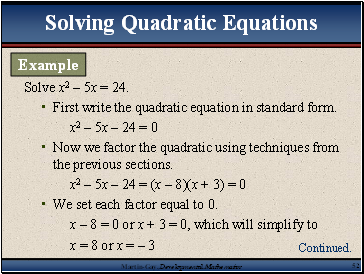
Solve x2 – 5x = 24.
First write the quadratic equation in standard form.
x2 – 5x – 24 = 0
Now we factor the quadratic using techniques from the previous sections.
x2 – 5x – 24 = (x – 8)(x + 3) = 0
We set each factor equal to 0.
x – 8 = 0 or x + 3 = 0, which will simplify to
x = 8 or x = – 3
Solving Quadratic Equations
Example
Continued.
Slide 53
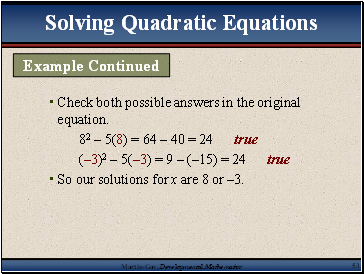
Check both possible answers in the original equation.
82 – 5(8) = 64 – 40 = 24 true
(–3)2 – 5(–3) = 9 – (–15) = 24 true
So our solutions for x are 8 or –3.
Example Continued
Solving Quadratic Equations
Slide 54
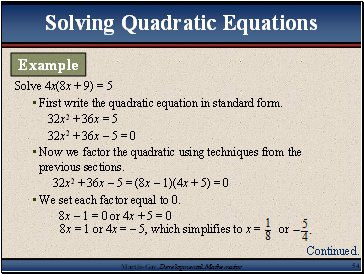
Solve 4x(8x + 9) = 5
First write the quadratic equation in standard form.
32x2 + 36x = 5
32x2 + 36x – 5 = 0
Now we factor the quadratic using techniques from the previous sections.
32x2 + 36x – 5 = (8x – 1)(4x + 5) = 0
We set each factor equal to 0.
8x – 1 = 0 or 4x + 5 = 0
Solving Quadratic Equations
Example
Continued.
Slide 55
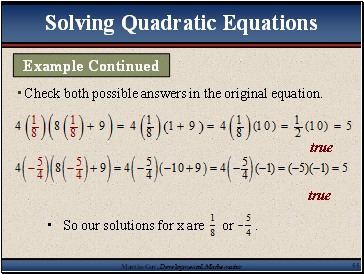
Check both possible answers in the original equation.
Example Continued
Solving Quadratic Equations
Slide 56
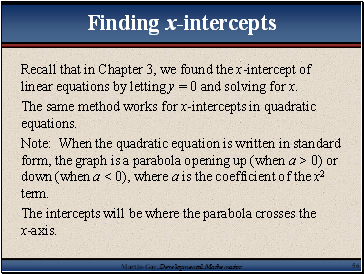
Finding x-intercepts
Recall that in Chapter 3, we found the x-intercept of linear equations by letting y = 0 and solving for x.
The same method works for x-intercepts in quadratic equations.
Note: When the quadratic equation is written in standard form, the graph is a parabola opening up (when a > 0) or down (when a < 0), where a is the coefficient of the x2 term.
The intercepts will be where the parabola crosses the x-axis.
Slide 57
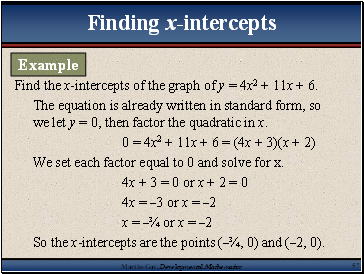
Find the x-intercepts of the graph of y = 4x2 + 11x + 6.
The equation is already written in standard form, so we let y = 0, then factor the quadratic in x.
0 = 4x2 + 11x + 6 = (4x + 3)(x + 2)
Contents
- Factoring Polynomials
- The Greatest Common Factor
- Factoring Polynomials
- Factoring out the GCF
- Factoring
- Factoring Trinomials
- Factoring Polynomials
- Prime Polynomials
- Factoring Trinomials
- Factoring Polynomials
- Factoring by Grouping
- Perfect Square Trinomials
- Difference of Two Squares
- Zero Factor Theorem
- Solving Quadratic Equations
- Finding x-intercepts
- Strategy for Problem Solving
- Finding an Unknown Number
- Pythagorean Theorem
Last added presentations
- Waves & Sound
- Radiation Safety and Operations
- Heat-Energy on the Move
- Sound
- Newton's laws of motion
- Gravitation
- Thermal Energy
